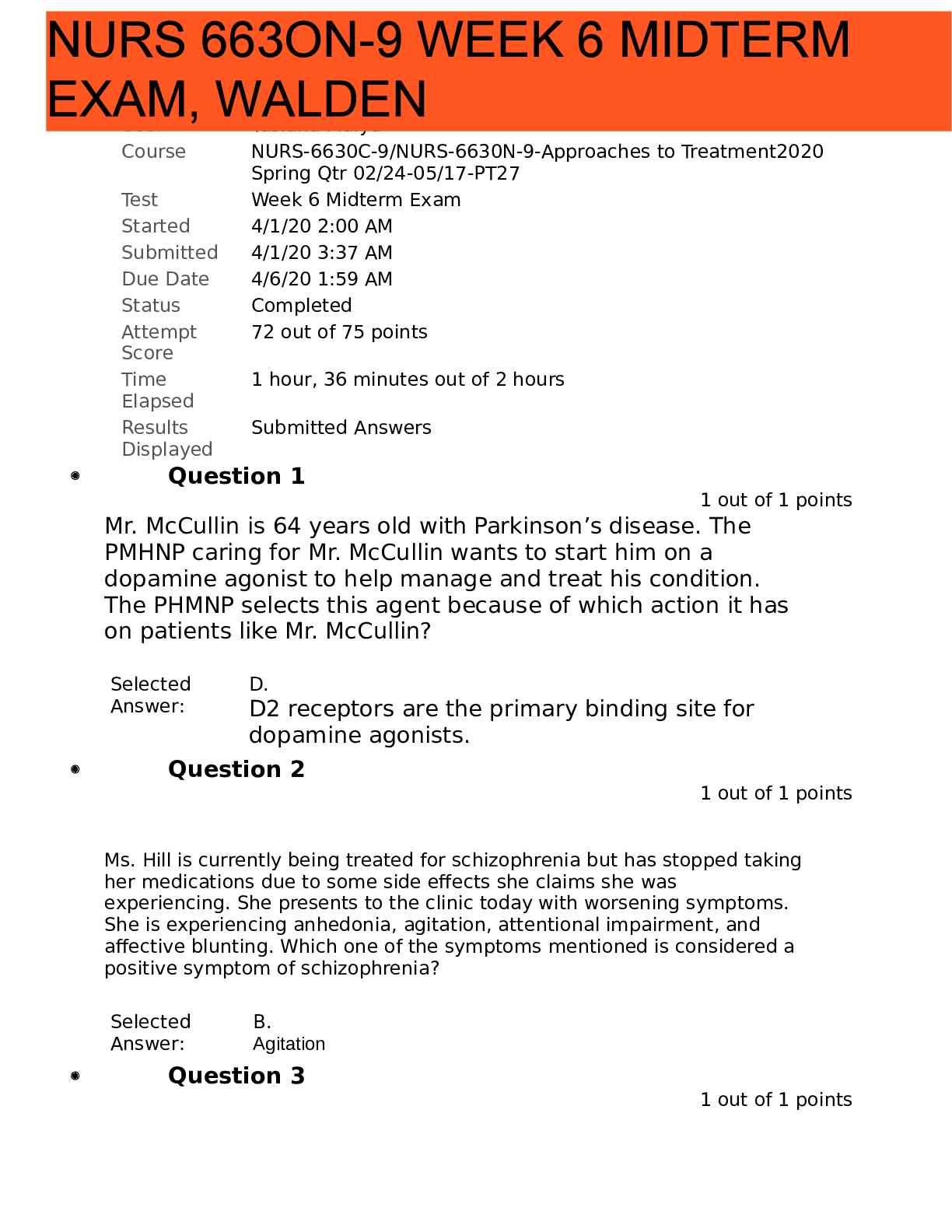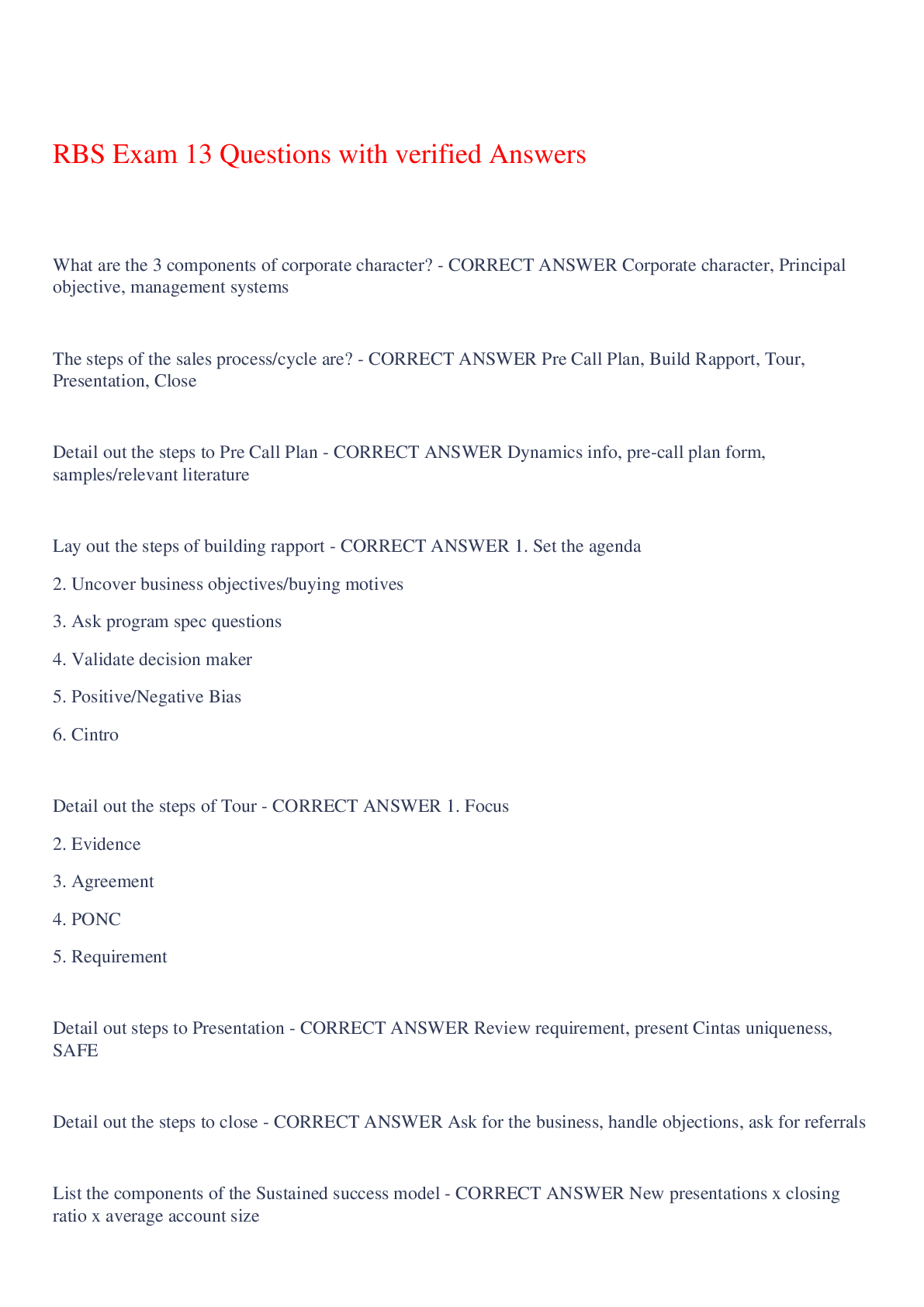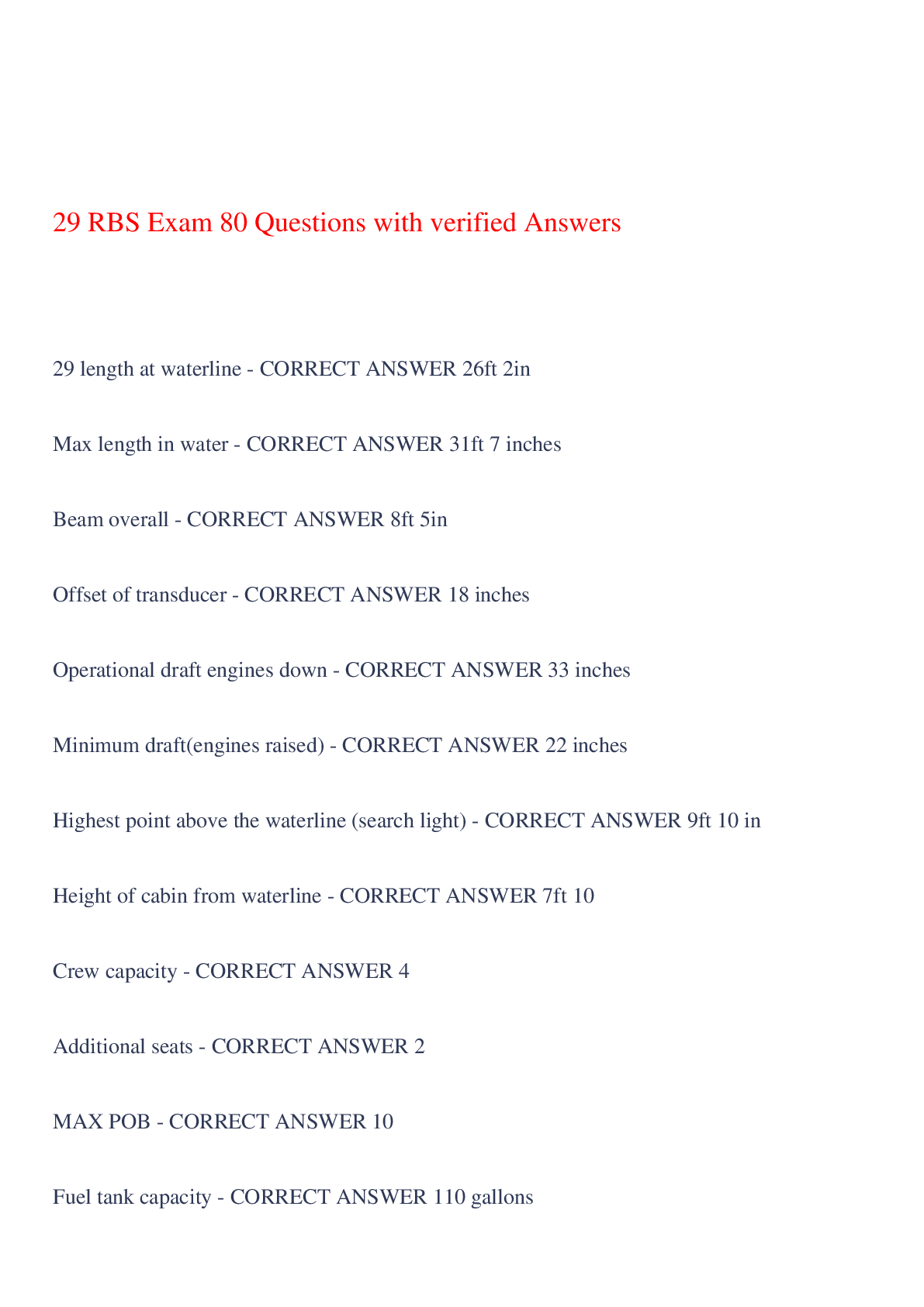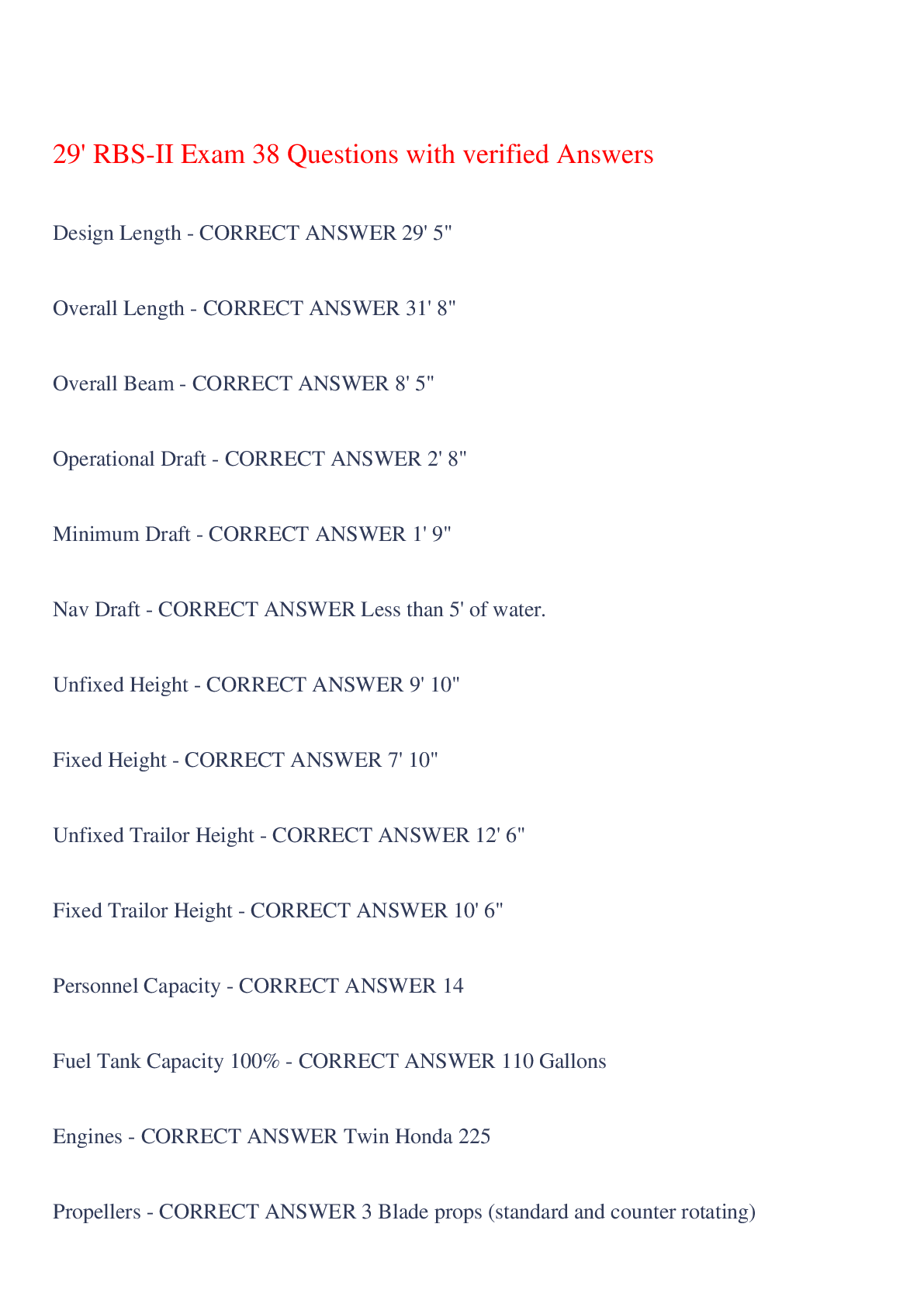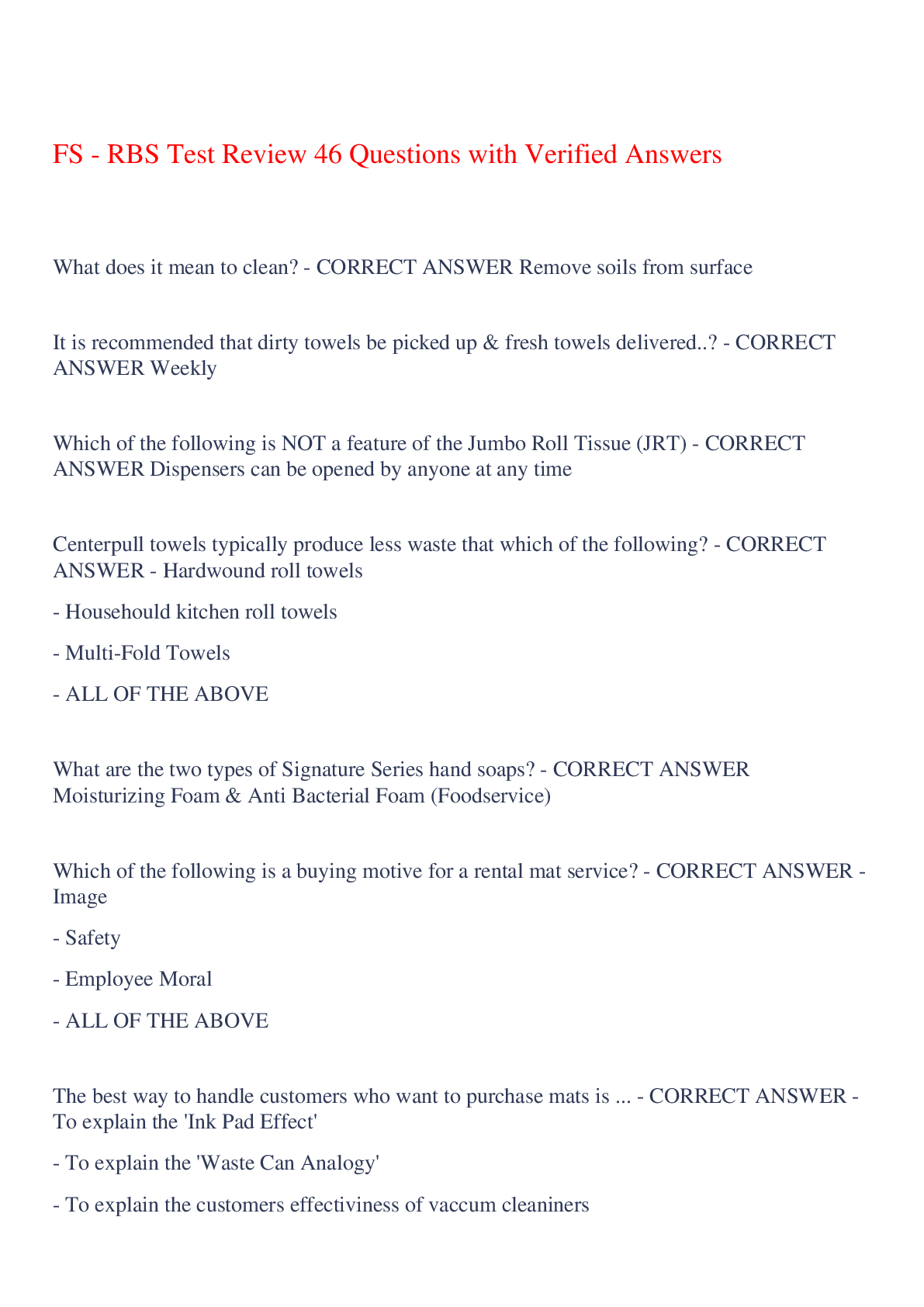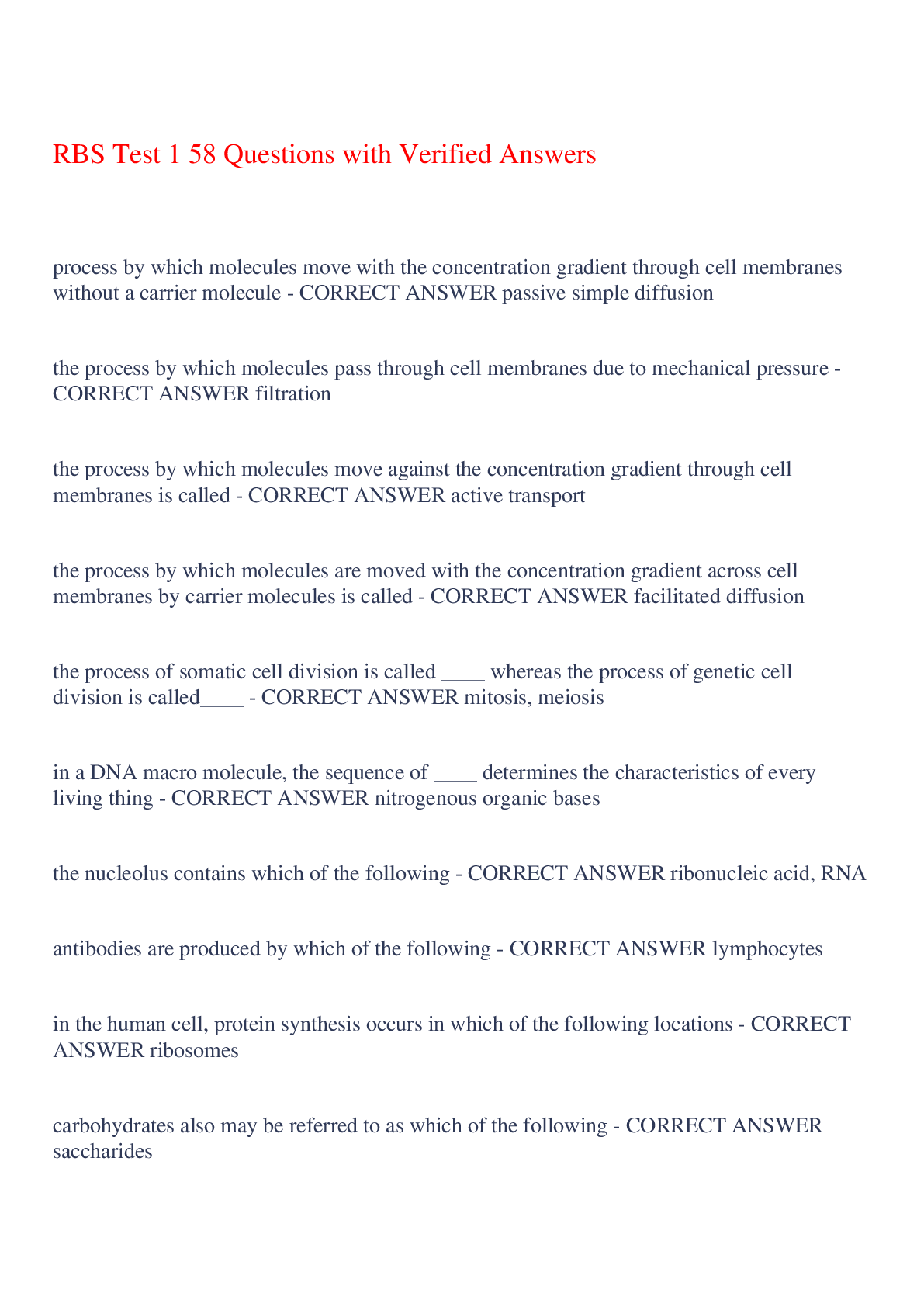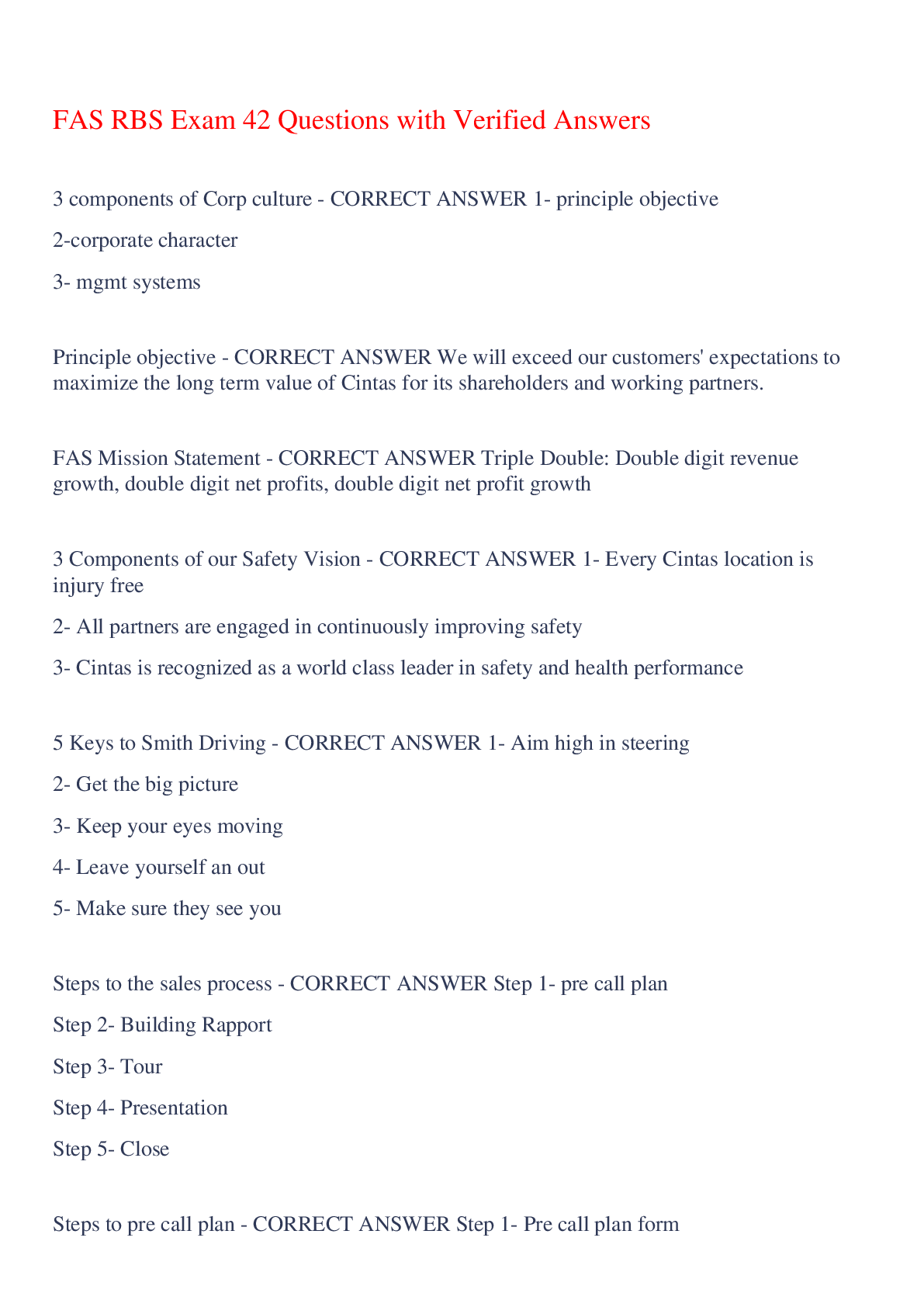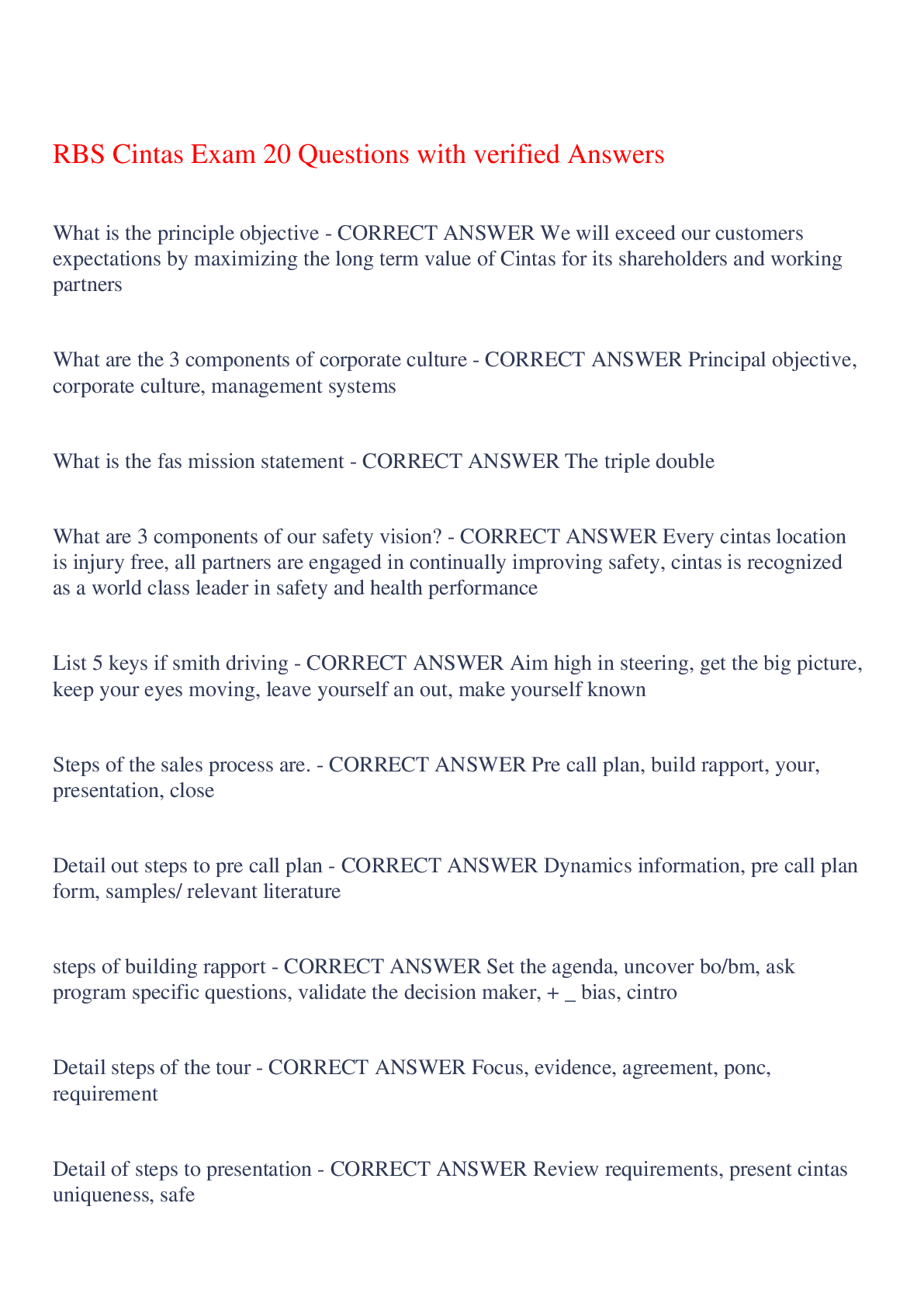NCLEX Final Exam 76 Questions with Verified Answers,100% CORRECT
Document Content and Description Below
NCLEX Final Exam 76 Questions with Verified Answers A 38-year-old female is brought to the Emergency Department with complaints of her "heart beating out of her chest". She is diaphoretic, tachypne... ic and her BP is 70/40. The cardiac monitor shows supraventricular tachycardia. Valsalva maneuvers and three doses of Adenosine have not been successful. The nurse should immediately: a.) prepare the patient for synchronized cardioversion. b.) give Epinephrine 1 mg IV and repeat in 3 minutes. c.) give Adenosine 6 mg IV per protocol. d.) perform unilateral carotid massage. - CORRECT ANSWER a.) prepare the patient for synchronized cardioversion. A patient arrives at the emergency department complaining of mid-sternal chest pain. Which of the following nursing action should take priority? A. A complete history with emphasis on preceding events. B. An electrocardiogram. C. Careful assessment of vital signs. D. Chest exam with auscultation. - CORRECT ANSWER Answer: C The priority nursing action for a patient arriving at the ED in distress is always assessment of vital signs. This indicates the extent of physical compromise and provides a baseline by which to plan further assessment and treatment. A thorough medical history, including onset of symptoms, will be necessary and it is likely that an electrocardiogram will be performed as well, but these are not the first priority. Similarly, chest exam with auscultation may offer useful information after vital signs are assessed. A nurse is caring for a patient who has had hip replacement. The nurse should be most concerned about which of the following findings? A. Complaints of pain during repositioning. B. Scant bloody discharge on the surgical dressing. C. Complaints of pain following physical therapy. D. Temperature of 101.8 F (38.7 C). - CORRECT ANSWER Answer: D Post-surgical nursing assessment after hip replacement should be principally concerned with the risk of neurovascular complications and the development of infection. A temperature of 101.8 F (38.7 C) postoperatively is higher than the low grade that is to be expected and should raise concern. Some pain during repositioning and following physical therapy is to be expected and can be managed with analgesics. A small amount of bloody drainage on the surgical dressing is a result of normal healing. Emergency department triage is an important nursing function. A nurse working the evening shift is presented with four patients at the same time. Which of the following patients should be assigned the highest priority? A. A patient with low-grade fever, headache, and myalgias for the past 72 hours. B. A patient who is unable to bear weight on the left foot, with swelling and bruising following a running accident. C. A patient with abdominal and chest pain following a large, spicy meal. D. A child with a one-inch bleeding laceration on the chin but otherwise well after falling while jumping on his bed. - CORRECT ANSWER Answer: C Emergency triage involves quick patient assessment to prioritize the need for further evaluation and care. Patients with trauma, chest pain, respiratory distress, or acute neurological changes are always classified number one priority. Though the patient with chest pain presented in the question recently ate a spicy meal and may be suffering from heartburn, he also may be having an acute myocardial infarction and require urgent attention. The patient with fever, headache and muscle aches (classic flu symptoms) should be classified as non-urgent. The patient with the foot injury may have sustained a sprain or fracture, and the limb should be x-rayed as soon as is practical, but the damage is unlikely to worsen if there is a delay. The child's chin laceration may need to be sutured but is also non-urgent. A nurse cares for a patient who has a nasogastric tube attached to low suction because of a suspected bowel obstruction. Which of the following arterial blood gas results might be expected in this patient? A. pH 7.52, PCO2 54 mm Hg. B. pH 7.42, PCO2 40 mm Hg. C. pH 7.25, PCO2 25 mm Hg. D. pH 7.38, PCO2 36 mm Hg. - CORRECT ANSWER Answer: A A patient on nasogastric suction is at risk of metabolic alkalosis as a result of loss of hydrochloric acid in gastric fluid. Of the answers given, only answer A (pH 7.52, PCO2 54 mm Hg) represents alkalosis. Answer B is a normal blood gas. Answer C represents respiratory acidosis. Answer D is borderline normal with slightly low PCO2. A patient is admitted to the emergency department after sustaining abdominal injuries and a broken femur from a motor vehicle accident. The patient is pale, diaphoretic, and is not talking coherently. Vital signs upon admission are temperature 98 F (36 C), heart rate 130 beats/minute, respiratory rate 34 breaths/minute, blood pressure 50/40 mmHg. The healthcare provider suspects which type of shock? a.) Hypovolemic b.) Cardiogenic c.) Neurogenic d.) Septic - CORRECT ANSWER a.) Hypovolemic The healthcare provider is caring for a patient who has septic shock. Which of these should the healthcare provider administer to the patient first? a.) Antibiotics to treat the underlying infection. b.) Corticosteroids to reduce inflammation. c.) IV fluids to increase intravascular volume. d.) Vasopressors to increase blood pressure. - CORRECT ANSWER c.) IV fluids to increase intravascular volume. Rationale: Circulation and perfusion are addressed first so IV fluids will be started immediately. After blood cultures are obtained, broad-spectrum antibiotics should be administered without delay. Vasopressors are administered if the patient is not responding to the fluid challenge. Corticosteroids may be considered to address the inflammatory-induced vasodilation and capillary leakage Which of the following assessment findings is an early indication of hypovolemic shock? a.) Diminished bowel sounds b.) Increased urinary output c.) Tachycardia d.) Hypertension - CORRECT ANSWER c.) Tachycardia Rationale: Tachycardia is an early symptom as the body compensates for a declining blood pressure the heart rate increases to circulate the blood faster to prevent tissue hypoxia. When compensatory mechanisms for hypovolemic shock are activated, the nurse would expect which two patient findings to normalize? a.) Intensity of peripheral pulses and body temperature. b.) Peripheral pulses and heart rate (HR). c.) Metabolic alkalosis and oxygen saturation. d.) Cardiac output (CO) and blood pressure (BP). - CORRECT ANSWER d.) Cardiac output (CO) and blood pressure (BP). A client is progressing into the third stage of shock. The nurse will expect this client to demonstrate: Choose all that apply: a.) Intractable circulatory failure. b.) Neuroendocrine responses. c.) Demonstrating MODS. d.) Buildup of metabolic wastes. e.) Profound hypotension. f.) Increase in lactic acidosis. - CORRECT ANSWER c.) Demonstrating MODS. d.) Buildup of metabolic wastes. A client has been diagnosed with sepsis. The nurse will most likely find which of the following when assessing this client: Select all that apply: a.) Rapid shallow respirations. b.) Severe hypotension. c.) Mental status changes. d.) Elevated temperature. e.) Lactic acidosis. f.) Oliguria. - CORRECT ANSWER a.) Rapid shallow respirations. d.) Elevated temperature. Dobutamine (Dobutrex) is used to treat a client experiencing cardiogenic shock. Nursing intervention includes: a.) Monitoring for fluid overload. b.) Monitoring for cardiac dysrhythmias. c.) Monitoring respiratory status. d.) Monitoring for hypotension. - CORRECT ANSWER b.) Monitoring for cardiac dysrhythmias. Rationale: Dobutamine is beneficial in cases where shock is caused by heart failure. The drug increases contractility, and has the potential to cause dysrhythmias. A patient with hypovolemic shock has a urinary output of 15 ml/hr. The nurse understands that the compensatory physiologic mechanism that leads to altered urinary output is a.) activation of the sympathetic nervous system (SNS), causing vasodilation of the renal arteries. b.) stimulation of cardiac -adrenergic receptors, leading to increased cardiac output. c.) release of aldosterone and antidiuretic hormone (ADH), which cause sodium and water retention. d.) movement of interstitial fluid to the intravascular space, increasing renal blood flow. - CORRECT ANSWER c.) release of aldosterone and antidiuretic hormone (ADH), which cause sodium and water retention. Rationale: The release of aldosterone and ADH lead to the decrease in urine output by increasing the reabsorption of sodium and water in the renal tubules. SNS stimulation leads to renal artery vasoconstriction. -Receptor stimulation does increase cardiac output, but this would improve urine output. During shock, fluid leaks from the intravascular space into the interstitial space. A patient with massive trauma and possible spinal cord injury is admitted to the ED. The nurse suspects that the patient may be experiencing neurogenic shock in addition to hypovolemic shock, based on the finding of a.) cool, clammy skin. b.) shortness of breath. c.) heart rate of 48 beats/min d.) BP of 82/40 mm Hg. - CORRECT ANSWER c.) heart rate of 48 beats/min Rationale: The normal sympathetic response to shock/hypotension is an increase in heart rate. The presence of bradycardia suggests unopposed parasympathetic function, as occurs in neurogenic shock. The other symptoms are consistent with hypovolemic shock. A child reports to the camp nurse's office after stepping on a bee. The child has pain, erythema, and edema of the lower aspect of the left foot. As the nurse is observing the foot, the child says, "I feel like my throat is getting tight." The first action the nurse should take is: a) assess the child's airway and breathing b) call 911 and request an ambulance c) administer subcutaneous epinephrine d) remove the stinger from the foot - CORRECT ANSWER a.) access the child's airway and breathing Rationale: The situation indicates that the child is having anaphylactic reaction. The first action by the nurse is to assess airway and breathing. Priority assessment is ABC. A client admitted to the hospital with a subarachnoid hemorrhage has complaints of severe headache, nuchal rigidity, and projectile vomiting. The nurse knows lumbar puncture (LP) would be contraindicated in this client in which of the following circumstances? a.) Vomiting continues b.) Intracranial pressure (ICP) is increased c.) The client needs mechanical ventilation d.) Blood is anticipated in the cerebralspinal fluid (CSF) - CORRECT ANSWER b.) Intracranial pressure (ICP) is increased Rationale: Sudden removal of CSF results in pressures lower in the lumbar area than the brain and favors herniation of the brain; therefore, LP is contraindicated with increased ICP. Vomiting may be caused by reasons other than increased ICP; therefore, LP isn't strictly contraindicated. An LP may be preformed on clients needing mechanical ventilation. Blood in the CSF is diagnostic for subarachnoid hemorrhage and was obtained before signs and symptoms of ICP. The nurse is caring for the client with increased intracranial pressure. The nurse would note which of the following trends in vital signs if the ICP is rising? a.) Increasing temperature, increasing pulse, increasing respirations, decreasing blood pressure. b.) Increasing temperature, decreasing pulse, decreasing respirations, increasing blood pressure. c.) Decreasing temperature, decreasing pulse, increasing respirations, decreasing blood pressure. d.) Decreasing temperature, increasing pulse, decreasing respirations, increasing blood pressure. - CORRECT ANSWER b.) Increasing temperature, decreasing pulse, decreasing respirations, increasing blood pressure. Rationale: A change in vital signs may be a late sign of increased intracranial pressure. Trends include increasing temperature and blood pressure and decreasing pulse and respirations. Respiratory irregularities also may arise. Which of the following would lead the nurse to suspect that a child with meningitis has developed disseminated intravascular coagulation (DIC)? a.) Hemorrhagic skin rash b.) Edema c.) Cyanosis d.) Dyspnea on exertion - CORRECT ANSWER a.) Hemorrhagic skin rash Rationale: DIC is characterized by skin petechiae and a purpuric skin rash caused by spontaneous bleeding into the tissues. An abnormal coagulation phenomenon causes the condition. A lumbar puncture is performed on a child suspected of having bacterial meningitis. CSF is obtained for analysis. A nurse reviews the results of the CSF analysis and determines that which of the following results would verify the diagnosis? a.) Cloudy CSF, decreased protein, and decreased glucose b.) Cloudy CSF, elevated protein, and decreased glucose c.) Clear CSF, elevated protein, and decreased glucose d.) Clear CSF, decreased pressure, and elevated protein - CORRECT ANSWER b.) Cloudy CSF, elevated protein, and decreased glucose Rationale: A diagnosis of meningitis is made by testing CSF obtained by lumbar puncture. In the case of bacterial meningitis, findings usually include an elevated pressure, turbid or cloudy CSF, elevated leukocytes, elevated protein, and decreased glucose levels. A nurse is reviewing the record of a child with increased ICP and notes that the child has exhibited signs of decerebrate posturing. On assessment of the child, the nurse would expect to note which of the following if this type of posturing was present? a.) Abnormal flexion of the upper extremities and extension of the lower extremities b.) Rigid extension and pronation of the arms and legs c.) Rigid pronation of all extremities d.) Flaccid paralysis of all extremities - CORRECT ANSWER b.) Rigid extension and pronation of the arms and legs Rationale: Decebrate posturing is characterized by the rigid extension and pronation of the arms and legs. To evaluate the effectiveness of prescribed therapies for a patient with ventilatory failure, which diagnostic test will be most useful to the nurse? a. Chest x-rays b. Pulse oximetry c. Arterial blood gas (ABG) analysis d. Pulmonary artery pressure monitoring - CORRECT ANSWER ANS: C ABG analysis is most useful in this setting because ventilatory failure causes problems with CO2 retention, and ABGs provide information about the PaCO2 and pH. The other tests also may be done to help in assessing oxygenation or determining the cause of the patient's ventilatory failure. While caring for a patient who has been admitted with a pulmonary embolism, the nurse notes a change in the patient's oxygen saturation (SpO2) from 94% to 88%. The nurse will a. increase the oxygen flow rate. b. suction the patient's oropharynx. c. assist the patient to cough and deep breathe. d. help the patient to sit in a more upright position. - CORRECT ANSWER ANS: A Increasing oxygen flow rate usually will improve oxygen saturation in patients with ventilation-perfusion mismatch, as occurs with pulmonary embolism. Because the problem is with perfusion, actions that improve ventilation, such as deep-breathing and coughing, sitting upright, and suctioning, are not likely to improve oxygenation. A patient with respiratory failure has a respiratory rate of 8 and an SpO2 of 89%. The patient is increasingly lethargic. The nurse will anticipate assisting with a. administration of 100% oxygen by non-rebreather mask. b. endotracheal intubation and positive pressure ventilation. c. insertion of a mini-tracheostomy with frequent suctioning. d. initiation of bilevel positive pressure ventilation (BiPAP). - CORRECT ANSWER ANS: B The patient's lethargy, low respiratory rate, and SpO2 indicate the need for mechanical ventilation with ventilator-controlled respiratory rate. Administration of high flow oxygen will not be helpful because the patient's respiratory rate is so low. Insertion of a mini-tracheostomy will facilitate removal of secretions, but it will not improve the patient's respiratory rate or oxygenation. BiPAP requires that the patient initiate an adequate respiratory rate to allow adequate gas exchange. When admitting a patient in possible respiratory failure with a high PaCO2, which assessment information will be of most concern to the nurse? a. The patient is somnolent. b. The patient's SpO2 is 90%. c. The patient complains of weakness. d. The patient's blood pressure is 162/94. - CORRECT ANSWER ANS: A Increasing somnolence will decrease the patient's respiratory rate and further increase the PaCO2 and respiratory failure. Rapid action is needed to prevent respiratory arrest. An SpO2 of 90%, weakness, and elevated blood pressure all require ongoing monitoring but are not indicators of possible impending respiratory arrest. Which statement by the nurse when explaining the purpose of positive end-expiratory pressure (PEEP) to the family members of a patient with ARDS is correct? a. "PEEP will prevent fibrosis of the lung from occurring." b. "PEEP will push more air into the lungs during inhalation." c. "PEEP allows the ventilator to deliver 100% oxygen to the lungs." d. "PEEP prevents the lung air sacs from collapsing during exhalation." - CORRECT ANSWER ANS: D By preventing alveolar collapse during expiration, PEEP improves gas exchange and oxygenation. PEEP will not prevent the fibrotic changes that occur with ARDS, push more air into the lungs, or change the fraction of inspired oxygen (FIO2) delivered to the patient. The nurse obtains the vital signs for a patient admitted 2 days ago with gram-negative sepsis: temperature 101.2° F, blood pressure 90/56 mm Hg, pulse 92, respirations 34. Which action should the nurse take next? a. Administer the scheduled IV antibiotic. b. Give the PRN acetaminophen (Tylenol) 650 mg. c. Obtain oxygen saturation using pulse oximetry. d. Notify the health care provider of the patient's vital signs. - CORRECT ANSWER ANS: C The patient's increased respiratory rate in combination with the admission diagnosis of gram-negative sepsis indicates that acute respiratory distress syndrome (ARDS) may be developing. The nurse should check for hypoxemia, a hallmark of ARDS. The health care provider should be notified after further assessment of the patient. Administration of the scheduled antibiotic and administration of Tylenol also will be done, but they are not the highest priority for a patient who may be developing ARDS. After receiving change-of-shift report, which patient will the nurse assess first? a. A patient with cystic fibrosis who has thick, green-colored sputum b. A patient with pneumonia who has coarse crackles in both lung bases c. A patient with emphysema who has an oxygen saturation of 91% to 92% d. A patient with septicemia who has intercostal and suprasternal retractions - CORRECT ANSWER ANS: D This patient's history of septicemia and labored breathing suggest the onset of ARDS, which will require rapid interventions such as administration of oxygen and use of positive pressure ventilation. The other patients also should be assessed as quickly as possible, but their assessment data are typical of their disease processes and do not suggest deterioration in their status. A patient with ARDS who is receiving mechanical ventilation using synchronized intermittent mandatory ventilation (SIMV) has settings of fraction of inspired oxygen (FIO2) 80%, tidal volume 500, rate 18, and positive end-expiratory pressure (PEEP) 5 cm. Which assessment finding is most important for the nurse to report to the health care provider? a. Oxygen saturation 99% b. Patient respiratory rate 22 breaths/min c. Crackles audible at lung bases d. Apical pulse rate 104 beats/min - CORRECT ANSWER ANS: A The FIO2 of 80% increases the risk for oxygen toxicity. Since the patient's O2 saturation is 99%, a decrease in FIO2 is indicated to avoid toxicity. The other patient data would be typical for a patient with ARDS and would not need to be urgently reported to the health care provider. Which nursing action will the home health nurse include in the plan of care for a patient with paraplegia in order to prevent autonomic dysreflexia? a. Assist with selection of a high protein diet. b. Use quad coughing to assist cough effort. c. Discuss options for sexuality and fertility. d. Teach the purpose of a prescribed bowel program. - CORRECT ANSWER ANS: D Fecal impaction is a common stimulus for autonomic dysreflexia. The other actions may be included in the plan of care but will not reduce the risk for autonomic dysreflexia. A patient with a neck fracture at the C5 level is admitted to the intensive care unit. During initial assessment of the patient, the nurse recognizes the presence of neurogenic shock on finding a. hypotension, bradycardia, and warm extremities. b. involuntary, spastic movements of the arms and legs. c. hyperactive reflex activity below the level of the injury. d. lack of movement or sensation below the level of the injury. - CORRECT ANSWER ANS: A Neurogenic shock is characterized by hypotension, bradycardia, and vasodilation leading to warm skin temperature. Spasticity and hyperactive reflexes do not occur at this stage of spinal cord injury. Lack of movement and sensation indicate spinal cord injury, but not neurogenic shock. A patient has an incomplete right spinal cord lesion at the level of T7, resulting in Brown-Séquard syndrome. Which nursing action should be included in the plan of care? a. Assessment of the patient for left leg pain b. Assessment of the patient for left arm weakness c. Positioning the patient's right leg when turning the patient d. Teaching the patient to look at the left leg to verify its position - CORRECT ANSWER ANS: C The patient with Brown-Séquard syndrome has loss of motor function on the ipsilateral side and will require the nurse to move the right leg. Pain sensation will be lost on the patient's left leg. Left arm weakness will not be a problem for a patient with a T7 injury. The patient will retain position sense for the left leg. A patient with a T1 spinal cord injury is admitted to the intensive care unit. The nurse will teach the patient and family that a. use of the shoulders will be preserved. b. full function of the patient's arms will be retained. c. total loss of respiratory function may occur temporarily. d. elevations in heart rate are common with this type of injury. - CORRECT ANSWER ANS: B The patient with a T1 injury can expect to retain full motor and sensory function of the arms. Use of only the shoulders is associated with cervical spine injury. Loss of respiratory function occurs with cervical spine injuries. Bradycardia is associated with injuries above the T6 level. A patient with paraplegia resulting from a T10 spinal cord injury has a neurogenic reflex bladder. Which action will the nurse include in the plan of care? a. Educate on the use of the Credé method. b. Teach the patient how to self-catheterize. c. Catheterize for residual urine after voiding. d. Assist the patient to the toilet every 2 hours. - CORRECT ANSWER ANS: B Because the patient's bladder is spastic and will empty in response to overstretching of the bladder wall, the most appropriate method is to avoid incontinence by emptying the bladder at regular intervals through intermittent catheterization. Assisting the patient to the toilet will not be helpful because the bladder will not empty. The Credé method is more appropriate for a bladder that is flaccid, such as occurs with a reflexic neurogenic bladder. Catheterization after voiding will not resolve the patient's incontinence. To evaluate the effectiveness of IV methylprednisolone (Solu-Medrol) given to a patient with a T4 spinal cord injury, which information is most important for the nurse to obtain? a. Leg strength and sensation b. Skin temperature and color c. Blood pressure and apical heart rate d. Respiratory effort and O2 saturation - CORRECT ANSWER ANS: A The purpose of methylprednisolone administration is to help preserve motor function and sensation. Therefore the nurse will assess this patient for lower extremity function. The other data also will be collected by the nurse, but they do not reflect the effectiveness of the methylprednisolone. A patient with a history of a T2 spinal cord injury tells the nurse, "I feel awful today. My head is throbbing, and I feel sick to my stomach." Which action should the nurse take first? a. Assess for a fecal impaction. b. Give the prescribed antiemetic. c. Check the blood pressure (BP). d. Notify the health care provider. - CORRECT ANSWER ANS: C The BP should be assessed immediately in a patient with an injury at the T6 level or higher who complains of a headache to determine whether autonomic dysreflexia is occurring. Notification of the patient's health care provider is appropriate after the BP is obtained. Administration of an antiemetic is indicated after autonomic dysreflexia is ruled out as the cause of the nausea. The nurse may assess for a fecal impaction, but this should be done after checking the BP and lidocaine jelly should be used to prevent further increases in the BP. When caring for a patient who experienced a T1 spinal cord transsection 2 days ago, which collaborative and nursing actions will the nurse include in the plan of care (select all that apply)? a. Urinary catheter care b. Nasogastric (NG) tube feeding c. Continuous cardiac monitoring d. Avoidance of cool room temperature e. Administration of H2 receptor blockers - CORRECT ANSWER ANS: A, C, D, E The patient is at risk for bradycardia and poikilothermia caused by sympathetic nervous system dysfunction and should have continuous cardiac monitoring and maintenance of a relatively warm room temperature. Gastrointestinal (GI) motility is decreased initially and NG suctioning is indicated. To avoid bladder distention, a urinary retention catheter is used during this acute phase. Stress ulcers are a common complication but can be avoided through the use of the H2 receptor blockers such as famotidine. In which order will the nurse perform the following actions when caring for a patient with possible C6 spinal cord trauma who is admitted to the emergency department? Put a comma and space between each answer choice (a, b, c, d, etc.) ____________________ a. Infuse normal saline at 150 mL/hr. b. Monitor cardiac rhythm and blood pressure. c. Administer O2 using a non-rebreather mask. d. Transfer the patient to radiology for spinal computed tomography (CT). e. Immobilize the patient's head, neck, and spine. - CORRECT ANSWER ANS: E, C, B, A, D The first action should be to prevent further injury by stabilizing the patient's spinal cord. Maintenance of oxygenation by administration of 100% O2 is the second priority. Because neurogenic shock is a possible complication, monitoring of heart rhythm and BP are indicated, followed by infusing normal saline for volume replacement. A CT scan to determine the extent and level of injury is needed once initial assessment and stabilization are accomplished. A patient with acute kidney injury (AKI) has an arterial blood pH of 7.30. The nurse will assess the patient for a. vasodilation. b. poor skin turgor. c. bounding pulses. d. rapid respirations. - CORRECT ANSWER ANS: D Patients with metabolic acidosis caused by AKI may have Kussmaul respirations as the lungs try to regulate carbon dioxide. Bounding pulses and vasodilation are not associated with metabolic acidosis. Because the patient is likely to have fluid retention, poor skin turgor would not be a finding in AKI. Before administering sodium polystyrene sulfonate (Kayexalate) to a patient with hyperkalemia, the nurse should assess the a. blood urea nitrogen (BUN) and creatinine. b. blood glucose level. c. patient's bowel sounds. d. level of consciousness (LOC). - CORRECT ANSWER ANS: C Sodium polystyrene sulfonate (Kayexalate) should not be given to a patient with a paralytic ileus (as indicated by absent bowel sounds) because bowel necrosis can occur. The BUN and creatinine, blood glucose, and LOC would not affect the nurse's decision to give the medication. A patient needing vascular access for hemodialysis asks the nurse what the differences are between an arteriovenous (AV) fistula and a graft. The nurse explains that one advantage of the fistula is that it a. is much less likely to clot. b. increases patient mobility. c. can accommodate larger needles. d. can be used sooner after surgery. - CORRECT ANSWER ANS: A AV fistulas are much less likely to clot than grafts, although it takes longer for them to mature to the point where they can be used for dialysis. The choice of an AV fistula or a graft does not have an impact on needle size or patient mobility. A patient with chronic kidney disease (CKD) brings all home medications to the clinic to be reviewed by the nurse. Which medication being used by the patient indicates that patient teaching is required? a. Multivitamin with iron b. Milk of magnesia 30 mL c. Calcium phosphate (PhosLo) d. Acetaminophen (Tylenol) 650 mg - CORRECT ANSWER ANS: B Magnesium is excreted by the kidneys, and patients with CKD should not use over-the-counter products containing magnesium. The other medications are appropriate for a patient with CKD. Which of the following information obtained by the nurse who is caring for a patient with end-stage renal disease (ESRD) indicates the nurse should consult with the health care provider before giving the prescribed epoetin alfa (Procrit)? a. Creatinine 1.2 mg/dL b. Oxygen saturation 89% c. Hemoglobin level 13 g/dL d. Blood pressure 98/56 mm Hg - CORRECT ANSWER ANS: C High hemoglobin levels are associated with a higher rate of thromboembolic events and increased risk of death from serious cardiovascular events (heart attack, heart failure, stroke) when EPO is administered to a target hemoglobin of >12 g/dL. Hemoglobin levels higher than 12 g/dL indicate a need for a decrease in epoetin alfa dose. The other information also will be reported to the health care provider, but will not affect whether the medication is administered Two hours after a kidney transplant, the nurse obtains all of the following data when assessing the patient. Which information is most important to communicate to the health care provider? a. The urine output is 900 to 1100 mL/hr. b. The blood urea nitrogen (BUN) and creatinine levels are elevated. c. The patient's central venous pressure (CVP) is decreased. d. The patient has level 8 (on a 10-point scale) incisional pain. - CORRECT ANSWER ANS: C The decrease in CVP suggests hypovolemia, which must be rapidly corrected to prevent renal hypoperfusion and acute tubular necrosis. The other information is not unusual in a patient after a transplant. A patient in the oliguric phase of acute renal failure has a 24-hour fluid output of 150 mL emesis and 250 mL urine. The nurse plans a fluid replacement for the following day of ___ mL. a. 400 b. 800 c. 1000 d. 1400 - CORRECT ANSWER ANS: C Usually fluid replacement should be based on the patient's measured output plus 600 mL/day for insensible losses. When the nurse applies a painful stimulus to the nail beds of an unconscious patient, the patient responds with internal rotation, adduction, and flexion of the arms. The nurse documents this as a. flexion withdrawal. b. localization of pain. c. decorticate posturing. d. decerebrate posturing. - CORRECT ANSWER ANS: C Internal rotation, adduction, and flexion of the arms in an unconscious patient is documented as decorticate posturing. Extension of the arms and legs is decerebrate posturing. Because the flexion is generalized, it does not indicate localization of pain or flexion withdrawal. A patient with a head injury opens the eyes to verbal stimulation, curses when stimulated, and does not respond to a verbal command to move but attempts to remove a painful stimulus. The nurse records the patient's Glasgow Coma Scale score as a. 9. b. 11. c. 13. d. 15. - CORRECT ANSWER ANS: B The patient has a score of 3 for eye opening, 3 for best verbal response, and 5 for best motor response. A patient who is suspected of having an epidural hematoma is admitted to the emergency department. Which action will the nurse plan to take? a. Administer IV furosemide (Lasix). b. Initiate high-dose barbiturate therapy. c. Type and crossmatch for blood transfusion. d. Prepare the patient for immediate craniotomy. - CORRECT ANSWER ANS: D The principal treatment for epidural hematoma is rapid surgery to remove the hematoma and prevent herniation. If intracranial pressure (ICP) is elevated after surgery, furosemide or high-dose barbiturate therapy may be needed, but these will not be of benefit unless the hematoma is removed. Minimal blood loss occurs with head injuries, and transfusion is usually not necessary. A patient who has bacterial meningitis is disoriented and anxious. Which nursing action will be included in the plan of care? a. Encourage family members to remain at the bedside. b. Apply soft restraints to protect the patient from injury. c. Keep the room well-lighted to improve patient orientation. d. Minimize contact with the patient to decrease sensory input. - CORRECT ANSWER ANS: A Patients with meningitis and disorientation will be calmed by the presence of someone familiar at the bedside. Restraints should be avoided because they increase agitation and anxiety. The patient requires frequent assessment for complications; the use of touch and a soothing voice will decrease anxiety for most patients. The patient will have photophobia, so the light should be dim. When assessing a patient with bacterial meningitis, the nurse obtains the following data. Which finding should be reported immediately to the health care provider? a. The patient has a positive Kernig's sign. b. The patient complains of having a stiff neck. c. The patient's temperature is 101° F (38.3° C). d. The patient's blood pressure is 86/42 mm Hg. - CORRECT ANSWER ANS: D Shock is a serious complication of meningitis, and the patient's low blood pressure indicates the need for interventions such as fluids or vasopressors. Nuchal rigidity and a positive Kernig's sign are expected with bacterial meningitis. The nurse should intervene to lower the temperature, but this is not as life threatening as the hypotension. Which assessment finding in a patient who was admitted the previous day with a basilar skull fracture is most important to report to the health care provider? a. Bruising under both eyes b. Complaint of severe headache c. Large ecchymosis behind one ear d. Temperature of 101.5° F (38.6° C) - CORRECT ANSWER ANS: D Patients who have basilar skull fractures are at risk for meningitis, so the elevated temperature should be reported to the health care provider. The other findings are typical of a patient with a basilar skull fracture. An unconscious patient with a traumatic head injury has a blood pressure of 126/72 mm Hg, and an intracranial pressure of 18 mm Hg. The nurse will calculate the cerebral perfusion pressure as ____________________. - CORRECT ANSWER ANS: 72 mm Hg The formula for calculation of cerebral perfusion pressure is [(Systolic pressure + Diastolic blood pressure 2)/3] = intracranial pressure. Which laboratory data would reflect early signs of renal tubular damage? A. Decreased hemoglobin level B. Increased serum sodium level C. Increased serum calcium level D. Decreased urine specific gravity - CORRECT ANSWER ANS: D A decrease in urine specific gravity indicates a loss of urine-concentrating ability and is the earliest sign of renal tubular damage. Which laboratory data alteration would the nurse expect to see manifested in a client with renal failure? A. Hypokalemia and metabolic acidosis B. Hyperkalemia and metabolic alkalosis C. Hyperphosphatemia and hypocalcemia D. Hypophosphatemia and hypercalcemia - CORRECT ANSWER ANS: C Normally, a reciprocal relationship exists between calcium and phosphate, which is mediated by vitamin D. In renal failure, hyperphosphatemia and hypocalcemia result from a deficiency of activated vitamin D and decreased tubular excretion of phosphate. A decrease in the GFR (glomerular filtration rate) increases the plasma phosphate level, leading to hyperphosphatemia. As phosphate levels increase, phosphate binds to calcium, resulting in a decrease in the serum calcium levels. In the presence of less activated vitamin D, less calcium can be absorbed through the intestinal mucosa. A client with suspected diminished renal functioning has come to the outpatient clinic for an appointment. What laboratory test would be most accurate in assessing this client's renal reserve? A. 24-hour urine for creatinine clearance B. Serum blood urea nitrogen level C. Urine specific gravity D. Serum sodium level - CORRECT ANSWER ANS: A A 24-hour creatinine clearance test is necessary to detect changes in renal reserve. Creatinine clearance is a measure of the glomerular filtration rate. The ability of the glomeruli to act as a filter is decreased in renal disease. What statement regarding renal insufficiency (stage II) is true? A. Renal function is reduced, but there is no accumulation of metabolic wastes. B. The healthier kidney compensates for the diseased kidney. C. There is decreased responsiveness to diuretics. D. The kidneys are unable to maintain homeostasis - CORRECT ANSWER ANS: C Stage II renal insufficiency is characterized by a decreased responsiveness to diuretics, the beginning accumulation of metabolic wastes, and decreasing GFR. Which of the following manifestations would alert the nurse to a potentially dangerous complication in the client with chronic renal failure? A. Nausea and vomiting B. Soft, less audible heart sounds C. Paresthesias of the hands and feet D. Anemia accompanied by folic acid deficiencies - CORRECT ANSWER ANS: B Soft, less audible heart sounds can signal the accumulation of fluid within the pericardial sac. Fluid accumulation results from the accumulation of uremic toxins causing inflammation of the pericardium and subsequent fluid buildup. Excessive amounts of fluid within the pericardial sac can result in cardiac tamponade, a medical-surgical emergency. A client with chronic renal failure has developed uremic pericarditis. In assessing the cardiovascular system of this client, what sounds would the nurse expect to hear? A. A harsh, blowing murmur at the left sternal border B. An irregular heartbeat, accompanied by a precordial lift C. A pericardial friction rub, present in systole and diastole D. Soft, distant heart sounds accompanied by an S3 - CORRECT ANSWER ANS: C The classic sign of acute pericarditis is the scratchy sound associated with a pericardial friction rub. This sound can be heard in both systole and diastole. Soft, distant heart sounds can be present if the pericarditis is accompanied by an effusion Which assessment parameter should the nurse monitor in a client with chronic renal failure to determine fluid and sodium retention status? A. Weight and blood pressure B. Intake and output C. Muscle strength D. Capillary refill - CORRECT ANSWER ANS: A Weight and blood pressure are helpful in estimating fluid and sodium retention. Weight and blood pressure rise with excess fluid and sodium. A client has hypertension and chronic renal insufficiency. Which of the following are the most effective drugs for controlling hypertension and preserving renal function? A. Angiotension-converting enzyme inhibitors B. Beta-adrenergic blockers C. Calcium channel blockers D. Alpha-adrenergic blockers - CORRECT ANSWER ANS: A Research indicates that ACE inhibitors appear to be the most effective drugs to slow the progression of renal failure. It will be most important for the nurse to check pulse oximetry for which of these patients? a. A patient with emphysema and a respiratory rate of 16 b. A patient with massive obesity who is refusing to get out of bed c. A patient with pneumonia who has just been admitted to the unit d. A patient who has just received morphine sulfate for postoperative pain - CORRECT ANSWER C Rationale: Hypoxemia and hypoxemic respiratory failure are caused by disorders that interfere with the transfer of oxygen into the blood, such as pneumonia. The other listed disorders are more likely to cause problems with hypercapnia because of ventilatory failure. The nurse will monitor for clinical manifestations of hypercapnia when a patient in the emergency department has a. chest trauma and multiple rib fractures. b. carbon monoxide poisoning after a house fire. c. left-sided ventricular failure and acute pulmonary edema. d. tachypnea and acute respiratory distress syndrome (ARDS). - CORRECT ANSWER A Rationale: Hypercapnia is caused by poor ventilatory effort, which occurs in chest trauma when rib fractures (or flail chest) decrease lung ventilation. Carbon monoxide poisoning, acute pulmonary edema, and ARDS are more commonly associated with hypoxemia. A client is diagnosed with gestational hypertension and is receiving magnesium sulfate. Which finding would the nurse interpret as indicating a therapeutic level of medication? a.) Urinary output of 20 mL per hour b.) Respiratory rate of 10 breaths/minute c.) Deep tendons reflexes 2+ d.) Difficulty in arousing - CORRECT ANSWER Ans: C Response: With magnesium sulfate, deep tendon reflexes of 2+ would be considered normal and therefore a therapeutic level of the drug. Urinary output of less than 30 mL, a respiratory rate of less than 12 breaths/minute, and a diminished level of consciousness would indicate magnesium toxicity. Which one of the following findings would alert the nurse to the development of HELLP syndrome in a pregnant client? a.) Hyperglycemia b.) Elevated platelet count c.) Disseminated intravascular coagulopathy (DIC) d.) Elevated liver enzymes - CORRECT ANSWER Ans: D Response: HELLP is an acronym for hemolysis, elevated liver enzymes, and low platelets. Hyperglycemia is not a part of this syndrome. HELLP may increase the woman's risk for DIC. A 10-week pregnant woman with diabetes has a glycosylated hemoglobin (HbA1c) level of 13%. At this time the nurse should be most concerned about which of the following possible fetal outcomes? a.) Congenital anomalies b.) She won't be, this is a normal HbA1c level. c.) Placenta previa d.) Abruptio placentae - CORRECT ANSWER Ans: A Response: A HbA1c level of 13% indicates poor glucose control. This, in conjunction with the woman being in the first trimester, increases the risk for congenital anomalies in the fetus. Elevated glucose levels are not associated with incompetent cervix, placenta previa, or abruptio placentae. The nurse would be alert for possible placental abruption during labor when assessment reveals which of the following? A) Macrosomia B) Gestational hypertension C) Gestational diabetes D) Low parity - CORRECT ANSWER Ans: B Response: Risk factors for placental abruption include preeclampsia, gestational hypertension, seizure activity, uterine rupture, trauma, smoking, cocaine use, coagulation defects, previous history of abruption, domestic violence, and placental pathology. Macrosomia, gestational diabetes, and low parity are not considered risk factors. A woman with preterm labor is receiving magnesium sulfate. Which finding would require the nurse to intervene immediately? a.) Respiratory rate of 16 breaths per minute b.) Diminished deep tendon reflexes c.) Urine output of 45 mL/hour d.) Alert level of consciousness - CORRECT ANSWER Ans: B Response: Diminished deep tendon reflexes suggest magnesium toxicity, which requires immediate intervention. Additional signs of magnesium toxicity include a respiratory rate less than 12 breaths/minute, urine output less than 30 mL/hour, and a decreased level of consciousness. A patient who has had a subarachnoid hemorrhage is being cared for in the intensive care unit. Which information about the patient is most important to communicate to the health care provider? A) The patient's blood pressure is 90/50 mm Hg. B) The patient complains about having a stiff neck. C) The cerebrospinal fluid (CSF) report shows red blood cells (RBCs). D) The patient complains of an ongoing severe headache. - CORRECT ANSWER A) The patient's blood pressure is 90/50 mm Hg. Feedback: To prevent cerebral vasospasm and maintain cerebral perfusion, blood pressure needs to be maintained at a level higher than 90 mm Hg systolic after a subarachnoid hemorrhage. A low BP or drop in BP indicates a need to administer fluids and/or vasopressors to increase the BP. An ongoing headache, RBCs in the CSF, and a stiff neck are all typical clinical manifestations of a subarachnoid hemorrhage and do not need to be rapidly communicated to the health care provider. A patient with massive trauma and possible spinal cord injury is admitted to the emergency department (ED). Which finding by the nurse will help confirm a diagnosis of neurogenic shock? A) Cool, clammy skin B) Inspiratory crackles C) Apical heart rate 48 beats/min D) Temperature 101.2° F (38.4° C) - CORRECT ANSWER C) Apical heart rate 48 beats/min Feedback: Neurogenic shock is characterized by hypotension and bradycardia. The other findings would be more consistent with other types of shock. After receiving 1000 mL of normal saline, the central venous pressure for a patient who has septic shock is 10 mm Hg, but the blood pressure is still 82/40 mm Hg. The nurse will anticipate the administration of A) nitroglycerine (Tridil). B) drotrecogin alpha (Xigris). C) norepinephrine (Levophed). D) sodium nitroprusside (Nipride). - CORRECT ANSWER C) norepinephrine (Levophed). Feedback: When fluid resuscitation is unsuccessful, vasopressor drugs are administered to increase the systemic vascular resistance (SVR) and improve tissue perfusion. Nitroglycerin would decrease the preload and further drop cardiac output and BP. Drotrecogin alpha may decrease inappropriate inflammation and help prevent systemic inflammatory response syndrome, but it will not directly improve blood pressure. Nitroprusside is an arterial vasodilator and would further decrease SVR Which information obtained by the nurse when caring for a patient who has cardiogenic shock indicates that the patient may be developing multiple organ dysfunction syndrome (MODS)? A) The patient's serum creatinine level is elevated. B) The patient complains of intermittent chest pressure. C) The patient has crackles throughout both lung fields. D) The patient's extremities are cool and pulses are weak. - CORRECT ANSWER A) The patient's serum creatinine level is elevated. Feedback: The elevated serum creatinine level indicates that the patient has renal failure as well as heart failure. The crackles, chest pressure, and cool extremities are all consistent with the patient's diagnosis of cardiogenic shock. When caring for a patient who has septic shock, which assessment finding is most important for the nurse to report to the health care provider? A) BP 92/56 mm Hg B) Skin cool and clammy C) Apical pulse 118 beats/min D) Arterial oxygen saturation 91% - CORRECT ANSWER B) Skin cool and clammy Feedback: Since patients in the early stage of septic shock have warm and dry skin, the patient's cool and clammy skin indicates that shock is progressing. The other information also will be reported, but does not indicate deterioration of the patient's status. The nurse obtains a health history from a 65-year-old patient with a prosthetic mitral valve who has symptoms of infective endocarditis (IE). Which question by the nurse is most appropriate? a. "Do you have a history of a heart attack?" b. "Is there a family history of endocarditis?" c. "Have you had any recent immunizations?" d. "Have you had dental work done recently?" - CORRECT ANSWER ANS: D Rationale: Dental procedures place the patient with a prosthetic mitral valve at risk for infective endocarditis (IE). Myocardial infarction (MI), immunizations, and a family history of endocarditis are not risk factors for IE. When caring for a patient with mitral valve stenosis, it is most important that the nurse assess for a. diastolic murmur. b. peripheral edema. c. shortness of breath on exertion. d. right upper quadrant tenderness. - CORRECT ANSWER ANS: C The pressure gradient changes in mitral stenosis lead to fluid backup into the lungs, resulting in hypoxemia and dyspnea. The other findings also may be associated with mitral valve disease but are not indicators of possible hypoxemia. A 21-year-old woman is scheduled for percutaneous transluminal balloon valvuloplasty to treat mitral stenosis. Which information should the nurse include when explaining the advantages of valvuloplasty over valve replacement to the patient? a. Biologic valves will require immunosuppressive drugs after surgery. b. Mechanical mitral valves need to be replaced sooner than biologic valves. c. Lifelong anticoagulant therapy will be needed after mechanical valve replacement. d. Ongoing cardiac care by a health care provider is not necessary after valvuloplasty. - CORRECT ANSWER ANS: C Long-term anticoagulation therapy is needed after mechanical valve replacement, and this would restrict decisions about career and childbearing in this patient. Mechanical valves are durable and last longer than biologic valves. All valve repair procedures are palliative, not curative, and require lifelong health care. Biologic valves do not activate the immune system, and immunosuppressive therapy is not needed. During discharge teaching with a 68-year-old patient who had a mitral valve replacement with a mechanical valve, the nurse instructs the patient on the a. use of daily aspirin for anticoagulation. b. correct method for taking the radial pulse. c. need for frequent laboratory blood testing. d. need to avoid any physical activity for 1 month. - CORRECT ANSWER ANS: C Anticoagulation with warfarin (Coumadin) is needed for a patient with mechanical valves to prevent clotting on the valve. This will require frequent international normalized ratio (INR) testing. Daily aspirin use will not be effective in reducing the risk for clots on the valve. Monitoring of the radial pulse is not necessary after valve replacement. Patients should resume activities of daily living as tolerated. After receiving report on the following patients, which patient should the nurse assess first? a. Patient with rheumatic fever who has sharp chest pain with a deep breath b. Patient with acute aortic regurgitation whose blood pressure is 86/54 mm Hg c. Patient with infective endocarditis who has a murmur and splinter hemorrhages d. Patient with dilated cardiomyopathy who has bilateral crackles at the lung bases - CORRECT ANSWER ANS: B Hypotension in patients with acute aortic regurgitation may indicate cardiogenic shock. The nurse should immediately assess this patient for other findings such as dyspnea or chest pain. The findings in the other patients are typical of their diagnoses and do not indicate a need for urgent assessment and intervention. [Show More]
Last updated: 7 months ago
Preview 1 out of 30 pages
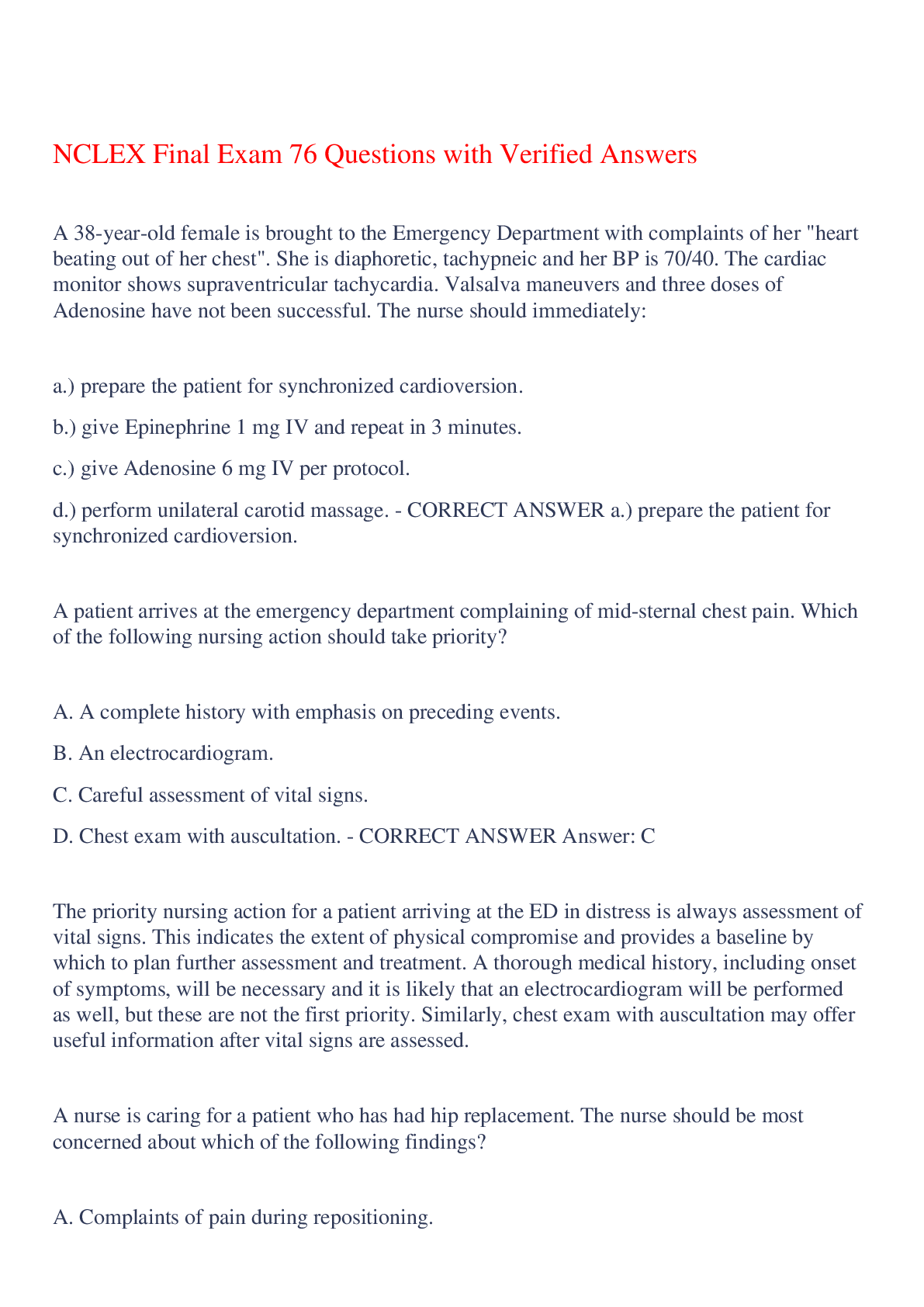
Buy this document to get the full access instantly
Instant Download Access after purchase
Add to cartInstant download
We Accept:

Reviews( 0 )
$9.50
Document information
Connected school, study & course
About the document
Uploaded On
Nov 13, 2023
Number of pages
30
Written in
Additional information
This document has been written for:
Uploaded
Nov 13, 2023
Downloads
0
Views
36














